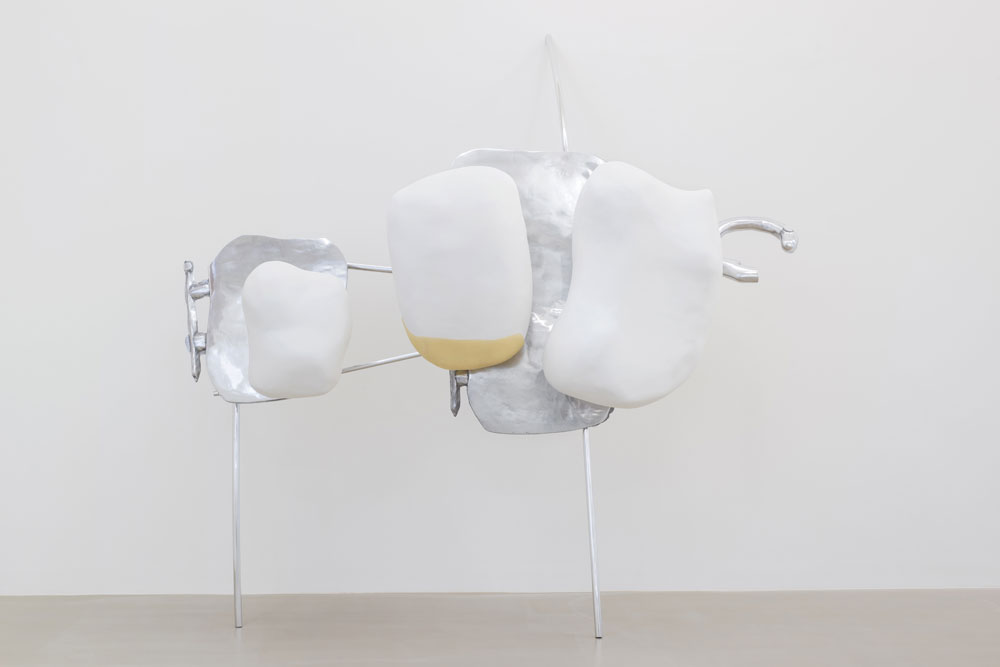Nairy Baghramian
Marian Goodman Gallery, London, UK
Marian Goodman Gallery, London, UK

The modern dental brace is commonly held to have been invented by Pierre Fauchard who, in the pages of his treatise The Surgeon Dentist (1728), describes an iron ‘bandeau’, secured by waxed linen or silk threads, contrived to slowly force teeth into their proper place. The intimate engineers of orthodontics later employed cribs of gold wire and, from the 1970s, braces were made of stainless steel, with brackets glued to the teeth. Whatever the design or materials, a certain force, even violence, has always been employed – anxiety, too – in perfecting an interior decor of the mouth.

Nairy Baghramian’s sculpture has, for some time, strained with orthodontic tension. Retainer (2013) is an arc of chromed struts and cast-silicon lozenges; first shown at SculptureCenter in New York, it seemed to be holding the space together or pulling it apart. For her new show at Marian Goodman, the Berlin-based Iranian artist has made seven sculptures with an even more obvious dental reference. The guiding conceit, sparsely effected, is that we enter the exhibition as if infiltrating a giant head; the show shuttles jocoseriously between sculptural austerity and a sense that these works are about to chomp their way through the surrounding Soho streets.

Each piece in ‘Scruff of the Neck’ involves one to five pure white plaster forms – indeterminate blobs, really – attached to cast and polished aluminium shields of irregular and variable design. These are bolted, in turn, to polished metal rods, which either emerge cleanly from the wall or hang from gleaming square aluminium brackets. The retaining rods are taut and minimal, but all else is comparatively unformed and perhaps a little unclean. Squat rubber plugs or pucks connect the ‘teeth’ (let’s be over-literal for a moment) to metal, which is wrinkled or scarred in places and edged in rough, spiny bits of metal that look like, or are meant to resemble, residues of the casting process. Here and there, the white forms are thinly coated with beeswax:a weak yellow plaque flushed with pink, an encroaching reminder of flesh
and decay.

As ever with Baghramian, there is a knowing translation here between several states of matter. The sculptures seem highly sprung, as if they might leap into the otherwise vacant air of the large ground-floor gallery and even larger upstairs. The three pieces on the first floor are suspended three to five metres off the ground, like trophy suits of armour, some medieval prince’s heraldic achievements in burnished metal. On the ground floor, the works lean against the wall like alien athletes, stretching their thin, strange limbs and mirrored musculature. Throughout, there is the sense that the white larval (or is it molar?) forms enclose the most ancient sculptural ambitions; in each, something seems to be straining to emerge. (What is dentistry, after all, if not a species of miniature sculpture?)

Baghramian’s work has frequently cited the histories of (especially modernist) architecture, design, jewellery and decor. These are sculptures that, in some Cronenbergian universe – recall the monstrous gynaecological instruments in Dead Ringers (1988) – might also be a kind of furniture. There are clues in that direction. Attached to some of the works are elongated organic forms, also in polished aluminium. They closely resemble branches of coral – as if the notional head in question were ancient, ruined, sunk at the bottom of the ocean. At their extremities, these silvery dendrites sport flat polished roundels that suggest the whole sculpture ought to be placed on the floor to become a futuristic couch or chair, though heaven knows at what angle it would pose the body. Lie still, open wide.
Lead image: Scruff of the Neck (bone treat), 2016, c-type print, 140 x 77 cm























